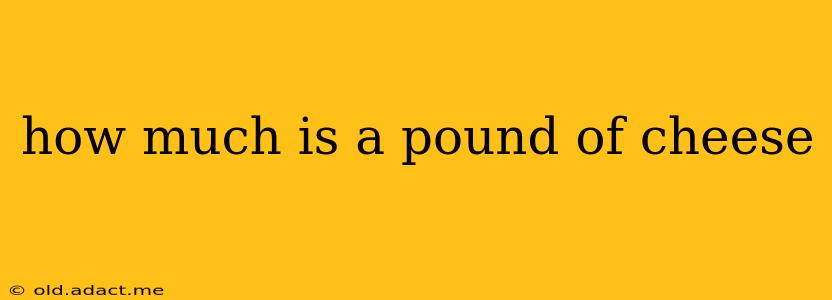How Much is a Pound of Cheese? A Deep Dive into Dairy Pricing
The price of a pound of cheese varies wildly depending on several factors. There's no single answer to this question, as the cost fluctuates based on the type of cheese, its production method, the store where you buy it, and even the time of year. Let's break down the key influences on cheese pricing to help you understand what you might expect to pay.
What Kinds of Cheese Exist, and How Does That Affect Price?
The sheer variety of cheese available is staggering! From the mild cheddar you might find in a basic supermarket to the complex, aged artisan cheeses found in specialty stores, the range is immense. Simple cheeses like mass-produced cheddar or mozzarella tend to be the most affordable, often falling into a price range of $6-$12 per pound. However, this price can jump significantly depending on the quality and fat content.
On the other end of the spectrum, artisanal cheeses, like aged gouda, Parmigiano-Reggiano, or certain blue cheeses, can cost anywhere from $15 to $30 or even more per pound. These cheeses often involve specialized production methods, longer aging periods, and higher-quality milk, all of which contribute to their higher price tag.
Does the Store Location Impact the Price of Cheese?
Absolutely! Supermarkets generally offer the most competitive prices on mass-produced cheeses. Discount grocery stores often provide even lower prices, though the selection may be more limited. Specialty cheese shops, while offering a wider array of unique and high-quality cheeses, will naturally charge more due to their curated selection and expert knowledge. Farmers' markets can also provide a range of prices depending on the producer and the cheese's characteristics.
How Does the Time of Year Affect Cheese Prices?
Seasonal variations can influence milk production, which in turn impacts cheese prices. For example, during periods of lower milk production, the cost of cheese may rise slightly. Conversely, periods of abundant milk supply may result in slightly lower cheese prices. These fluctuations are generally subtle and often overshadowed by the other factors mentioned.
Where Can I Find the Cheapest Cheese?
The cheapest cheese is generally found at larger supermarkets and discount grocery stores during sales periods. Look for store brands or larger blocks of cheese, as these often represent better value for money compared to individually packaged slices or smaller portions. Comparing unit prices (price per ounce or pound) is crucial when determining the best value.
What Factors Contribute to the High Cost of Some Cheeses?
Several factors contribute to the high price of certain cheeses:
- Type of Milk: Cheeses made from raw milk, organic milk, or milk from specific breeds of cows (like Jersey cows) command higher prices due to the increased cost of production.
- Aging Process: Longer aging periods require specialized facilities, meticulous care, and time, resulting in a higher final price for the consumer.
- Production Methods: Artisanal cheeses often involve labor-intensive, traditional methods that contribute to their higher cost.
- Demand and Rarity: Some cheeses are made in limited quantities, driving up demand and therefore price.
In conclusion, the price of a pound of cheese is highly variable and depends on numerous interacting factors. Understanding these nuances helps you make informed choices as a consumer, enabling you to find the best cheese to suit your budget and preferences.
